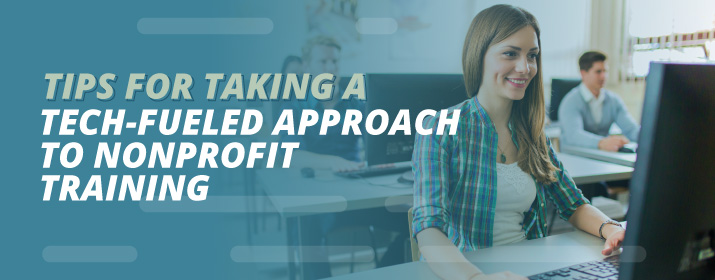Guest post blog submitted by: Artisan E-Learning, a nonprofit e-learning consultant.
What do your nonprofit training efforts look like right now?
We’d guess it’s some combination of:
- Weekly, monthly, or quarterly onboarding (with ad-hoc shadowing of staff members as needed) for volunteers.
- A yearly refresher course for staff members.
Both of which occur in-person in an instructor-led format.
These strategies aren’t uncommon. However, they’re not the only (or, we’d argue, the best) way to bring your team members up to speed.
Your organization uses nonprofit technology to track data, research donors, communicate with volunteers, and market upcoming opportunities. Why not use it to train your team as well?
Let’s walk through the benefits of using technology in your training strategy and how you can create e-learning courses that make an impact.
What are the benefits of a tech-fueled approach to nonprofit training?
“If it’s not broken, don’t fix it.”
We’ve all heard that before, and it can be true! If you have a training system that is serving your nonprofit well-meaning volunteers and staff members understand their roles, there have been few catastrophes due to insufficient training, etc., you may be hesitant to change things up by including technology.
But, just because your current in-person training efforts are technically working, that doesn’t mean that they’re the best solution for your overall organization, staff members, and volunteers alike. Taking a tech-fueled approach to nonprofit training comes with the following benefits:
- Increased Flexibility and Accessibility: One great example is volunteer orientation. We’d guess that you currently hold weekly, monthly, or even quarterly orientation sessions to welcome and train new volunteers. With e-learning, you don’t need to organize an in-person event and have a staff member on-hand to lead it—you can simply email course access each time a new supporter wants to join your ranks.
- Improved Knowledge Retention: Learners can take e-learning courses at their own pace, revisiting key topics to ensure they understand them. They can also complete the course again down the line if they’d like a refresh! This gives staff members and volunteers ample opportunities to learn a topic (as opposed to hearing it once during an in-person training session).
- Elevated Engagement and Interactivity: At Artisan, we worked with the American Red Cross to transform a less-than-engaging PowerPoint into a self-paced e-learning course. With visuals of the form and walk-through examples, we were able to put the content into context and make the information easier to process. Beyond engaging visuals and examples, however, you can also increase interactivity with hands-on activities such as audio review, sliders and dials, sorting and labeling, and more.
And last, but not least? You’ll save time and resources.
You’ll save staff time, as you won’t need to appoint someone to lead training sessions. This means more time toward your cause. And you’ll save resources, as you only need to purchase a course once. E-learning training can be used over and over without an ongoing investment.
It’s also easier to collect and manage data on the effectiveness of digital training. With in-person training, you may have attendance numbers and perhaps a final exam. E-learning can give you insight into course completion, the results of various assessment elements throughout the course, and even logistical aspects such as how long the course took.
Where does technology factor into your nonprofit’s training strategy?
Now that we’ve discussed the benefits of technology in nonprofit training, let’s get into the nitty-gritty of what this looks like in practice.
The most common tech solutions that you’ll encounter in nonprofit training include:
- Learning management software (LMS). An LMS is the hub of your learning program. It hosts your courses and discussion forums, empowers learners to track their progress, and tracks all of the data about your programming.
- Video conferencing software. This comes into play if you choose to host virtual instructor-led training events or webinars, and can be as simple as a free Zoom line or more complex, like built-in tools in your LMS.
- E-learning resources. This includes all of the digital training materials that you provide, including full-on courses, infographics, job aids, quick video tutorials, learning games, and more.
The success of your tech-fueled nonprofit training relies much less on the tools you use, but on how you use them. You could invest in the best LMS, but if the courses it hosts are sub-par, then the investment is moot.
So, let’s focus on how to create effective e-learning courses to train your team.
How can you create effective e-learning courses for your nonprofit?
Step into your staff members’ or volunteers’ shoes for a minute.
They’ve taken a job or signed up to give their time with your organization for one guiding reason—they’re passionate about your cause. They believe in the work of your organization and they want to play a role in advancing that work.
The last thing you want to do is dull that spark with ineffective e-learning courses. If they sign on and struggle to understand your training, don’t see how it’s applicable to their efforts, or are simply bored out of their minds, you’re setting them up for failure right from the start.
Here are a few tips we’ve found for creating impactful e-learning courses for nonprofit training:
- Focus on what will help trainees do their jobs better. You could create a course about the history of your nonprofit. But, does that really help your learners do their jobs better? Focus on the activities they will complete and the skills they need to complete them. For instance, a game-based course about food bank shelf organization would be great for a food bank volunteer.
- Use microlearning courses to highlight key skills. Microlearning courses are short learning experiences hyper-focused on one specific topic. For example, you might create a gamified microlearning course about phone solicitations. The course would walk learners through the ideal script for asking for donations over the phone and how to respond to various answers.
- Include interactive elements to make courses engaging. One of the big benefits of e-learning is that learners can play an active role in the course itself (rather than simply viewing a presentation). Consider using drag-and-drop, audio review, sliders and dials, labeling and sorting, or other interactive elements to draw learners into the fold.
- Build opportunities for learners to practice. For example, you can create a learning game focused on the best ways to respond to “No” answers from prospective donors. By building multiple levels into the game, the learner can practice their responses and learn from their mistakes multiple times in a risk-free environment.
And finally, work with an e-learning partner and nonprofit technology consultant to bring your training to life.
An e-learning content development expert will bring knowledge of both instructional design and e-learning best practices to the table, creating courses that help your learners do their jobs better. From there, a nonprofit tech strategy consultant can evaluate your tech stack and ensure that you have a strong foundation to host your e-learning programming. It’s the dream team!
Just because you haven’t run into major challenges with your nonprofit training program yet, that doesn’t mean there isn’t room for improvement.
Incorporating e-learning into your training is not only more efficient for your team, but it has major benefits for your learners too!
However, the way that you use technology is just as important as your choice to incorporate it. With these tips, you’ll create e-learning courses that are valuable and engaging.
 About the Author:
About the Author:
Amy Morrisey is the President of Artisan E-Learning and serves as Sales & Marketing Manager. Amy started with Artisan as a contract writer/instructional designer. She was our Production Manager for four years and helped the team to double its capacity. As President, she stays focused on maintaining the high standards our clients have grown to expect. She believes that staying close to our clients, our people, and our work is a smart way to do that. One of her favorite things to do in the e-learning world is jump in with a client to write a storyboard that is creative and application-based. Before working with Artisan, Amy spent 17 years in corporate training and development predominantly teaching leadership development and coaching teams and executives. She currently serves on the board of ATD Detroit.

